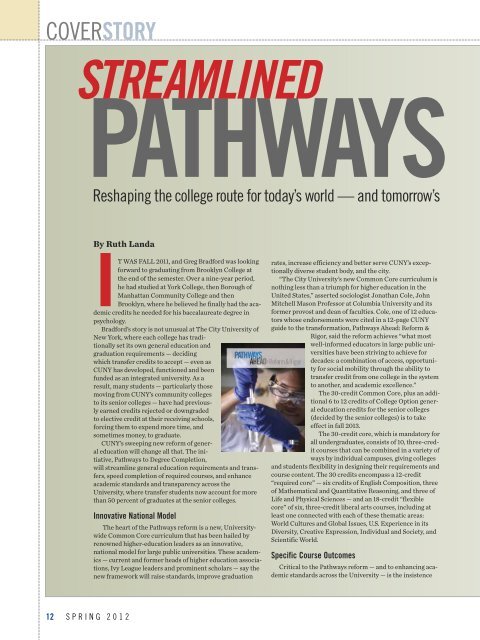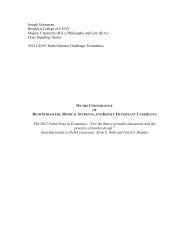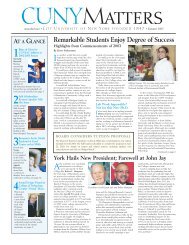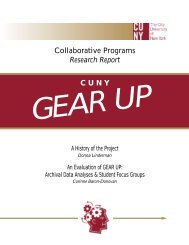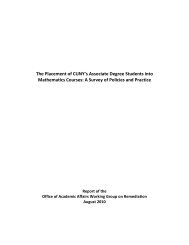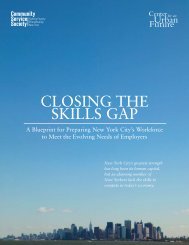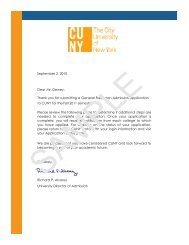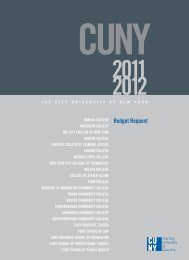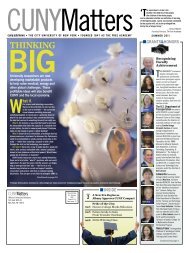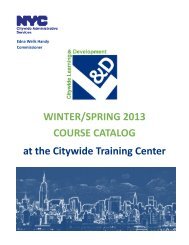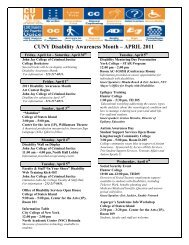Reform and Rigor in CUNY's Common Core
Reform and Rigor in CUNY's Common Core
Reform and Rigor in CUNY's Common Core
Create successful ePaper yourself
Turn your PDF publications into a flip-book with our unique Google optimized e-Paper software.
COVERSTORY<br />
STREAMLINED<br />
PATHWAYS<br />
Reshap<strong>in</strong>g the college route for today’s world — <strong>and</strong> tomorrow’s<br />
By Ruth L<strong>and</strong>a<br />
IT WAS FALL 2011, <strong>and</strong> Greg Bradford was look<strong>in</strong>g<br />
forward to graduat<strong>in</strong>g from Brooklyn College at<br />
the end of the semester. Over a n<strong>in</strong>e-year period,<br />
he had studied at York College, then Borough of<br />
Manhattan Community College <strong>and</strong> then<br />
Brooklyn, where he believed he f<strong>in</strong>ally had the academic<br />
credits he needed for his baccalaureate degree <strong>in</strong><br />
psychology.<br />
Bradford’s story is not unusual at The City University of<br />
New York, where each college has traditionally<br />
set its own general education <strong>and</strong><br />
graduation requirements — decid<strong>in</strong>g<br />
which transfer credits to accept — even as<br />
CUNY has developed, functioned <strong>and</strong> been<br />
funded as an <strong>in</strong>tegrated university. As a<br />
result, many students — particularly those<br />
mov<strong>in</strong>g from CUNY’s community colleges<br />
to its senior colleges — have had previously<br />
earned credits rejected or downgraded<br />
to elective credit at their receiv<strong>in</strong>g schools,<br />
forc<strong>in</strong>g them to expend more time, <strong>and</strong><br />
sometimes money, to graduate.<br />
CUNY’s sweep<strong>in</strong>g new reform of general<br />
education will change all that. The <strong>in</strong>itiative,<br />
Pathways to Degree Completion,<br />
will streaml<strong>in</strong>e general education requirements <strong>and</strong> transfers,<br />
speed completion of required courses, <strong>and</strong> enhance<br />
academic st<strong>and</strong>ards <strong>and</strong> transparency across the<br />
University, where transfer students now account for more<br />
than 50 percent of graduates at the senior colleges.<br />
Innovative National Model<br />
The heart of the Pathways reform is a new, Universitywide<br />
<strong>Common</strong> <strong>Core</strong> curriculum that has been hailed by<br />
renowned higher-education leaders as an <strong>in</strong>novative,<br />
national model for large public universities. These academics<br />
— current <strong>and</strong> former heads of higher education associations,<br />
Ivy League leaders <strong>and</strong> prom<strong>in</strong>ent scholars — say the<br />
new framework will raise st<strong>and</strong>ards, improve graduation<br />
rates, <strong>in</strong>crease efficiency <strong>and</strong> better serve CUNY’s exceptionally<br />
diverse student body, <strong>and</strong> the city.<br />
“The City University’s new <strong>Common</strong> <strong>Core</strong> curriculum is<br />
noth<strong>in</strong>g less than a triumph for higher education <strong>in</strong> the<br />
United States,” asserted sociologist Jonathan Cole, John<br />
Mitchell Mason Professor at Columbia University <strong>and</strong> its<br />
former provost <strong>and</strong> dean of faculties. Cole, one of 12 educators<br />
whose endorsements were cited <strong>in</strong> a 12-page CUNY<br />
guide to the transformation, Pathways Ahead: <strong>Reform</strong> &<br />
<strong>Rigor</strong>, said the reform achieves “what most<br />
well-<strong>in</strong>formed educators <strong>in</strong> large public universities<br />
have been striv<strong>in</strong>g to achieve for<br />
decades: a comb<strong>in</strong>ation of access, opportunity<br />
for social mobility through the ability to<br />
transfer credit from one college <strong>in</strong> the system<br />
to another, <strong>and</strong> academic excellence.”<br />
The 30-credit <strong>Common</strong> <strong>Core</strong>, plus an additional<br />
6 to 12 credits of College Option general<br />
education credits for the senior colleges<br />
(decided by the senior colleges) is to take<br />
effect <strong>in</strong> fall 2013.<br />
The 30-credit core, which is m<strong>and</strong>atory for<br />
all undergraduates, consists of 10, three-credit<br />
courses that can be comb<strong>in</strong>ed <strong>in</strong> a variety of<br />
ways by <strong>in</strong>dividual campuses, giv<strong>in</strong>g colleges<br />
<strong>and</strong> students flexibility <strong>in</strong> design<strong>in</strong>g their requirements <strong>and</strong><br />
course content. The 30 credits encompass a 12-credit<br />
“required core” — six credits of English Composition, three<br />
of Mathematical <strong>and</strong> Quantitative Reason<strong>in</strong>g, <strong>and</strong> three of<br />
Life <strong>and</strong> Physical Sciences — <strong>and</strong> an 18-credit “flexible<br />
core” of six, three-credit liberal arts courses, <strong>in</strong>clud<strong>in</strong>g at<br />
least one connected with each of these thematic areas:<br />
World Cultures <strong>and</strong> Global Issues, U.S. Experience <strong>in</strong> its<br />
Diversity, Creative Expression, Individual <strong>and</strong> Society, <strong>and</strong><br />
Scientific World.<br />
Specific Course Outcomes<br />
Critical to the Pathways reform — <strong>and</strong> to enhanc<strong>in</strong>g academic<br />
st<strong>and</strong>ards across the University — is the <strong>in</strong>sistence<br />
12 SPRING 2012


